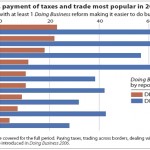Haiti’s Poverty Reduction Strategy – a performance measurement strategy

In the aftermath of the 7.0 magnitude earthquake of 2010, Haiti was left more or less in ruins and had to embark on an arduous reconstruction journey, starting with its infrastructure and ending with reforming its entire public and social system.
Due to its socio-economic context, the government has re-oriented its efforts from maximizing tourism, to achieving economic growth and reducing poverty.
Started from the bottom
Despite the fact that, according to the Human Development Index, Haiti’s trend has been continuously increasing, its progress is very small and it still is one of the countries with the lowest human development score, having been ranked as the 163rd country worldwide, in 2014, from this point of view.
The reforms put in place after the earthquake were shifted in an accelerated pace, between 2014 and 2016, as the goal of Haiti’s strategic development plan is to become a developing country by 2030, bringing together as many public and private actors as possible.
There are four strategic areas of intervention which are highlighted in its 3-year Investment Program, which is currently mobilizing all the available financial and non-financial resources in order for Haiti to achieve its vision:
- Territorial reconstruction, for which there were 8 proposed major programs;
- Economic reconstruction, which also has 8 intervention programs;
- Social reconstruction, through 9 programs; and
- Institutional reconstruction, which has 7 assigned programs.
Based on these four pillars and the prioritization of the needs of the nation, the government has decided to focus on the following areas in this 3-year process of improvement:
- Education and human and social development;
- The environment – reforming and developing their territory;
- The economy and employment;
- Energy;
- The rule of law and democracy.

Now, Haiti’s steadily going towards the top
A performance management system was implemented in order to measure and evaluate the programs put in place and their role in the overall achievement of the aforementioned general objectives.
The Government of Haiti drafted in its strategy paper, submitted to the International Monetary Fund, a comprehensive and complex performance measurement scheme, by formulating clear indicators and short-term targets.
The framework has established seven objectives and several clear and desired results indicators for each and every one, which can be measured and will ensure that the strategy is generating the desired change.
Furthermore, the targets for each results indicator are set on a year-to-year basis, and the paper gives a clear understanding of how these will act in practice and what is their desired impact in several years’ time. The aforementioned objectives are outlined below, listed according to the government’s priority:
- Job creation;
- Gender equality;
- Fighting social exclusion;
- Improving living conditions;
- Improving food security conditions;
- Improving risk and disaster management;
- Improving land management.
The programs implementation process began in the fiscal year 2012-2013, so the trend in the matrix followed the regular logic of such programs, by setting smaller targets to be achieved in the year 2014 and gradually increasing the target in 2015 for most indicators, based on each year’s results.
Another trend we observed, in the way these targets are set, is that the government maintained the same level of growth for most of the indicators used in both 2015 and 2016, therefore aiming to strengthen growth before further acceleration.

Haiti will rebuild!
A. Job creation was the first priority set because, according to the Human Development Index, in 2014, Haiti’s employment rate was only 61.2%. Hence, the focus and most important results indicator is the # Jobs created and the Government projected an increase with 50.000 new jobs created in 2014, raising the target to 100.000 for 2015 and 2016.
B. The assessment of the gender equality indicator is done through 5 results indicators – # Women in public decision-making positions, $ Public investments implemented by women, # Women in traditionally male trades, # Men in traditionally female trades, # Woman employed in the civil service.
As noticed, they focus on optimizing the workforce’s gender ratios in different trades – creating new opportunities for females in traditionally male trades and the other way around, with an increased attention to empowering women to obtain decision-making positions or become entrepreneurs.
The targets set for this objective, as well as for the next one – fighting social exclusion – are a 5% increase in the first year, followed by a 10% expected increase in 2015 and 2016.
C. Fighting the social exclusion priority topic has 5 results indicators attributed to it, focused on # Children enrolled in school, # Youth training, # Civic participation, # Persons with disabilities employed and % Extreme poverty reduction.
D. Through the forth priority point, improving living conditions, the Government of Haiti wants to measure the % Reduction in size of slums, increase in # Rehousing or the % Development of public spaces, as well as the reduction # Crime incidents.
Although the target set for reduction in size of slums is quite low, 1% in 2014 and 2015 and 2% in 2016, the priority is clearly set on rehousing families who have lost their homes, a figure which is expected to reach 35.000 in 2016.
E. The fifth objective, improving food security conditions, sets higher targets for % Agricultural and animal production, while decreasing the % Import of agricultural and animal production with the same ratio each year, and aims to also reduce the $ Basic food basket, but only with 1% each year.
F. The last two priorities, improving risk and disaster management and Improving land management, measure the positive environmental footprint – increasing % Forest coverage or watersheds, and land management, through taxation, # Land owners or % Land records accuracy, although the highest expected targets are on improving risk management, considering that Haiti is still struggling with the destruction suffered back in 2010.
The development paper states that based on the results achieved within these strategic priorities, “the real long-term progress should be evaluated”, however the matrix does not explain the methodology of gathering the necessary data and reporting it or how will long term success be measured.
Nonetheless, the framework designed by the Government of Haiti can be considered a reference point for a performance measurement matrix and an integrated, streamlined strategy, as it tackles the most important areas of desired improvement and sets measurable indicators and clear targets for each one of them.
Image sources:

Tags: Government performance, Performance in Haiti, World Bank




